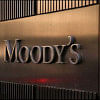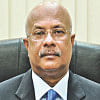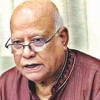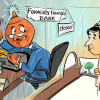Liquidity Crisis Deepens: Money is there, money is not
On the face of it, banks are awash with money. In September last year, excess liquidity of the banks totalled Tk 92,000 crore. The paradox is the banks do not have money when it comes to lending.
And now Corporate Bangladesh can say goodbye to the low lending rate era they had been enjoying for quite a few years when their cost of fund was quite low after years of high rates.
Bangladesh's banking system is going through a strange and critical phase right now. The banks are plagued by huge frauds. Bangladesh Bank investigations are revealing on a regular basis how different phony organisations had taken out huge sums in fake loans. How banks have violated all banking norms to lend to shady companies. How some flagship names in business with long dubious reputations have viciously schemed to get new loans in the name of repaying old loans which they then usurped up as well without paying a dime.
Let's take a look at a few cases, the tip of the iceberg may be, from as long back as 2009. Basic Bank's loan irregularities amounting to Tk 4,500 crore between 2009 and 2012 surfaced after the central bank's investigation.
Bismillah Group embezzled Tk 1,100 crore from five banks between 2011 and 2012. Sonali Bank's loan forgery of Tk 3,500 crore in 2012 also came to light recently. Beximco's controversial ingenious scheme of forcing a state-owned bank to guarantee a foreign loan to repay the local bank's default loan has broken all records.
Farmers Bank and NRB Commercial Bank became the latest examples of how money was taken out freely and liberally out of the system.
At the same time, a large number of banks had gone on an overdrive in lending, much of it to bad borrowers, that saw a phenomenal 19.06 percent growth in private loans much in excess of the targeted 16.2 percent. Low lending rates made bank money particularly attractive.
In December last year, lending rates went up to 13 percent, although big clients are getting loans at 10 percent, according to banks.
But the banks could not garnish their vaults with enough deposits because in order to lend cheap, they had to offer low rates on deposits too. The discouraged depositors found other places to park their money -- government savings instruments and leasing companies offering higher rates. Many of them even siphoned off capital abroad.
Correspondingly, deposit growth declined to about 11 percent in October last year (the latest figure not available) from 13.13 percent in December 2016.
And now banks are scrambling to puff up their deposit by offering interest rate as high as 9 percent.
Another factor came into play here. Many of their borrowers defaulted on or started delaying repayment. So the banks' cash flow management went haywire. Their receivables could not be realised on time, leading to deposit crisis. We see a spiraling of default loan increased to 10.67 percent in September last year against 9.23 percent a year before. Some Tk 15,000 crore worth of large loans were restructured in 2015 and most of these loans have fallen classified again.
Added to this was the Bangladesh Bank's set rules of lending. A bank has to maintain a certain advance-deposit ratio (ADR). It cannot lend above a certain percentage of its deposit amount. When this thing was happening, the ADR was 85 percent. The banks had already over-lent themselves without increasing deposit, straining their future lending capacity. To this was added the defaulted loans because any loan not paid in due time was added to the banks' asset column, making their ADR even worse.
Now all this has led to the current situation where the banks have become cash strapped despite having so much of excess liquidity in the system. They cannot lend as much as they want from their available deposit because they have to keep this money in till to maintain their asset-deposit ratio.
And now to contain inching inflation, the Bangladesh Bank is about to apply its monetary tool of cutting ADR to make even less money available to banks to lend. This will reduce money supply and curb inflation.
The banking system is also being gripped by other international factors as well -- the rising commodity prices is just one. Oil price has already been climbing steadily and reached $70 a barrel. Cotton price has started rising from last week too and India has already cancelled some big contracts.
So the pressure on dollar has increased, and following the simple economic thumb rule dollar has become pricier. This means importers now need more cash to buy dollar for the same amount of commodity. Since banks are their source of money, the banks are also under pressure to supply more money.
The mega projects are also adding more pressure on dollar as their import components are huge. Capital machinery import has increased by about 37 percent. Sugar, rice, wheat and cotton imports have risen also quite significantly.
All this have led to a new stress on the banking system that would ultimately roll into the economy as well.
AK Azad, former FBCCI president, expressed the fear that higher lending rate might interrupt investment and harm employment. He thinks the high irregularities in the banks have led to the current situation where genuine businessmen will be punished.

 For all latest news, follow The Daily Star's Google News channel.
For all latest news, follow The Daily Star's Google News channel. 








Comments